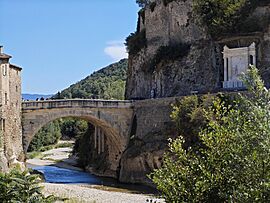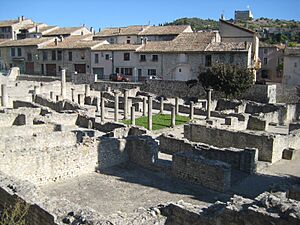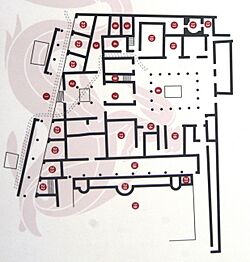Vaison-la-Romaine facts for kids
Quick facts for kids
Vaison-la-Romaine
|
||
|---|---|---|

Vaison-la-Romaine Roman Bridge
|
||
|
||
| Country | France | |
| Region | Provence-Alpes-Côte d'Azur | |
| Department | Vaucluse | |
| Arrondissement | Carpentras | |
| Canton | Vaison-la-Romaine | |
| Intercommunality | CC Vaison Ventoux | |
| Area
1
|
26.99 km2 (10.42 sq mi) | |
| Population
(2021)
|
5,929 | |
| • Density | 219.67/km2 (568.95/sq mi) | |
| Time zone | UTC+01:00 (CET) | |
| • Summer (DST) | UTC+02:00 (CEST) | |
| INSEE/Postal code |
84137 /84110
|
|
| Elevation | 156–493 m (512–1,617 ft) (avg. 204 m or 669 ft) |
|
| 1 French Land Register data, which excludes lakes, ponds, glaciers > 1 km2 (0.386 sq mi or 247 acres) and river estuaries. | ||
Vaison-la-Romaine is a town in southeastern France. It is located in the Vaucluse area, which is part of the Provence-Alpes-Côte d'Azur region.
This town is famous for its amazing Roman ruins. It also has a charming medieval town and an old cathedral. What makes Vaison-la-Romaine special is how its ancient, medieval, and modern parts are all close together. This shows 2,000 years of history in one place!
The old town is split into two main sections. One part is called the "upper city" or Colline du Château, which sits on a hill. The other part is the "lower city", centered on the Colline de la Villasse. These two parts are on opposite sides of the Ouvèze river.
Vaison-la-Romaine is also known for its art scene. It has four theaters and many art shows and galleries. Many writers, painters, and actors live in or near the town.
Contents
A Look at Vaison-la-Romaine's Past
The area where Vaison-la-Romaine is located has been lived in for a very long time. People were here even in the Bronze Age. Around 375 BC, Vaison became the main town for a Celtic tribe called the Vocontii. Their main settlement was an oppidum (a fortified town) in the upper city.
Vaison During Roman Times
The Romans took over this area between 125 and 118 BC. Even after the Roman conquest, the Vocontii tribe kept some control over their land. Vaison became one of their two capitals, named Vasio Julia Vocontiorum. The town slowly became more Roman.
At first, rich Vocontian families probably built houses near the river. These houses were different from the older Celtic ones. Later, the Romans planned the city with straight streets.
Large public buildings started to be built in the second half of the 1st century AD. These included a theater, a bridge, aqueducts, and public baths. Two aqueducts brought water to the city. One came from a hill nearby, and the other, longer one, came from a spring 10 kilometers away on Mont Ventoux.
The time of Roman peace, called the Pax Romana, helped the city grow. By the 2nd century AD, Vaison was very large, covering about 75 hectares (about 185 acres). It became one of the richest cities in the Roman province of Gallia Narbonensis.
Many houses with beautiful mosaic floors have been found here. There's also a great theater built on a rocky hillside. It was probably built when Emperor Tiberius was in charge. A famous statue of Tiberius was found in the theater. Another famous statue, the Vaison Diadumenos, was also found there. It is now in the British Museum.
Around 276 AD, the city was attacked and burned. But Roman Vasio recovered. Vaison also became an important Christian center. It had a bishop from the 4th century, and two important church meetings (councils) were held there in 442 and 529 AD.
After the Roman Empire
In the 5th century, tribes like the Burgundians invaded, and the city was badly damaged. The stone benches from the Roman theater were even used as tombstones for Christians. In 527, the Ostrogoths took Vaison. Then, in 545, Chlothar I, a King of the Franks, took control, and Vaison became part of Provence.
During the 12th century, there were disagreements between the counts of Provence and the bishops. Each group controlled half of the town, which hurt its growth. These problems ended in 1251 with a treaty.
In the Middle Ages, times were often unsafe. So, people moved to higher ground on the left bank of the Ouvèze river. They built strong walls and a castle for protection. But from the 18th century onwards, most people moved back down to the flatter land by the river.
A big flood hit Vaison-la-Romaine on September 22, 1992. It was the worst flood since 1632.
Population Growth in Vaison-la-Romaine
| Historical population | ||
|---|---|---|
| Year | Pop. | ±% p.a. |
| 1968 | 4,402 | — |
| 1975 | 5,210 | +2.44% |
| 1982 | 5,862 | +1.70% |
| 1990 | 5,663 | −0.43% |
| 1999 | 5,904 | +0.46% |
| 2007 | 6,248 | +0.71% |
| 2012 | 6,123 | −0.40% |
| 2017 | 5,999 | −0.41% |
| Source: INSEE | ||
What to See in Vaison-la-Romaine
The Roman ruins are in the valley, next to the Ouvèze river. A Roman bridge from the 1st century AD crosses the river here. The main Roman ruins are found in two areas: La Villasse and Puymin.
Several large and wealthy Roman houses have been dug up by archaeologists:
- The House of the Dolphin (covering 2,700 square meters)
- The House of the Laurelled Apollo (covering 2,000 square meters)
- The House of the Arbour (covering 3,000 square meters)
- The House of the Peacock (covering 1,000 square meters)
These houses likely belonged to the rich Vocontii families who owned land in the region. Many items found in Vaison-la-Romaine are now in museums around the world. About 25 museums, mostly in Europe and North America, have artifacts from this town.
The medieval town is built high on a rocky hill. This was a safer place because attacks were common during the Middle Ages. The town moved to this more protected spot.
The back part (apse) of the Church of St. Quenin is very old, possibly from the 8th century. This makes it one of the oldest churches in France. The main cathedral dates back to the 11th century. However, some parts of it, like the apse and small chapels, are from an even older period called the Merovingian period.
The town also has a famous open-air market every Tuesday, all year long.
The House of the Dolphin
The House of the Dolphin gets its name from a white marble fountain. This fountain showed a small angel (cupid) riding a dolphin. The way the house is built shows it was changed and added to over about 250 years.
Around 30 BC, it was a farmhouse covering 1,400 square meters. It was built differently from the later Roman street plan. The main entrance was on the south side. The main part of the building had four rooms around a courtyard with columns, called a peristyle. To the west, there were farm buildings and a small heated room, which was probably a bath.
About 50 years later, water and sewage pipes were added. This made living conditions much better. Around 80 AD, the house was made bigger. It expanded onto the land up to the new walking street. A new main entrance was built on the north side. The peristyle was made larger towards the east and had a pond. The upper floor of the house was also expanded.
The private part of the house had rooms built around the peristyle. The upper floor was reached by a staircase next to the tablinum, which was like an office or study.
Twin Towns
 Martigny, Switzerland
Martigny, Switzerland
Notable People from Vaison-la-Romaine
- Gnaeus Pompeius Trogus (1st century BC): A historian who was born here.
- Maurice Burrus: A tobacco businessman, politician, and stamp collector.
- Alice Colonieu: A French artist who worked with ceramics, painting, and sculpture.
- Michel Jeury: A French science fiction writer.
- Mimie Mathy: A French actress, comedian, and singer.
- Keira Knightley: An English actress who owns a house in the area.
- Henri Metzger (1912–2007): A French archaeologist and expert on ancient Greece who died here.
Images for kids
See also
 In Spanish: Vaison-la-Romaine para niños
In Spanish: Vaison-la-Romaine para niños













